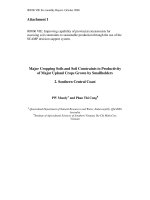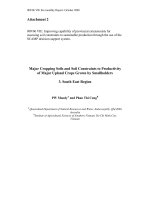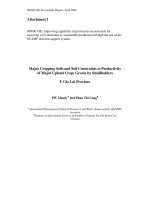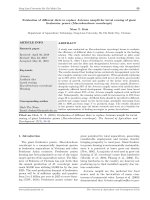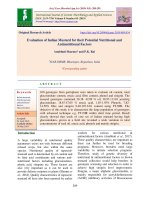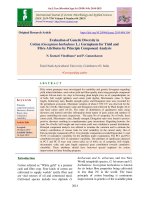Soil site suitability evaluation of crops for Dorika watershed of Assam
Bạn đang xem bản rút gọn của tài liệu. Xem và tải ngay bản đầy đủ của tài liệu tại đây (399.15 KB, 11 trang )
Int.J.Curr.Microbiol.App.Sci (2018) 7(10): 3214-3224
International Journal of Current Microbiology and Applied Sciences
ISSN: 2319-7706 Volume 7 Number 10 (2018)
Journal homepage:
Original Research Article
/>
Soil Site Suitability Evaluation of Crops for Dorika Watershed of Assam
Arunima Gogoi1*, M.C. Talukdar2, A. Basumatary2, U. Baruah3 and J. Deka2
1
Citrus Research Station, Assam Agricultural University, Tinsukia-786125, Assam, India
2
Department of Soil Science, Assam Agricultural University, Jorhat-785013, India
3
Regional centre NBSS & LUP (ICAR), Jorhat, India
*Corresponding author
ABSTRACT
Keywords
Soil site suitability
evaluation,
Watershed, Water
harvesting structure
Article Info
Accepted:
24 September 2018
Available Online:
10 October 2018
The present study was undertaken to prepare land use plan for Dorika watershed of
Sivasagar District in Assam based on soil site suitability evaluation of crops. The area
׳
׳
׳
coverage of this watershed comprises between 26048 to 27003 N latitude and 94027 to
׳
0
94 52 E longitude. The watershed boundaries were delineated based on Survey of India
toposheet (1:50,000) no. 83J/13, 83J/9, 83I/12 and I/8 and. R2 L4 MX Remote sensing
data. Generally, the soils under this watershed were found to be strongly acidic, high
organic carbon content, low in CEC, medium to high base saturation and texture varies
from coarse to fine texture. Soil pH, Drainage and nutrient constraints were the limiting
factors for potential utilization of the land resources. Soil site suitability of crops was
evaluated for crops such as rice, mustard, potato, tea etc. Several crops are recommended
depending on their suitability for the post rainy season in the soils which are kept fallow in
the present land use system. Rice is the main crop under this watershed and cultivated
during the rainy season due to imperfect drainage though the soils are moderately and
marginally suitable. In present study, it was observed that low precipitation in early crop
growth stage or growing cycle during rabi crops is one of the major constraints. To deal
with such situations or dry spells, for cultivation of rabi crops, it becomes necessary to
harvest rainwater in water harvesting structures for life saving or supplementary irrigation.
So, harvesting or storing of rainwater appears to be an alternative proposition. Results of
this study revealed that the study area under rice fallow cropping system could be modified
into double cropping system with the use of proper fertility management and life saving
irrigation.
Introduction
Sivasagar district of Assam occupies an area
of 2, 66,800 ha constituting 3.40 per cent of
the states geographical area (Dutta, 2009).
Dorika is one of the major rivers in Sivasagar
district. Dorika watershed covers an area of
27,352.5 ha. The watershed atlas code of
Dorika watershed is 3B3D1 (All India Soil
and Land Use Survey, 1990). The river Dorika
originates from the foothills areas of Assam
bordering Nagaland flows though Sivsagar
district and merge into the river Dikhou near
Brahmaputra. Finally, falls in to the river
Brahmaputra. More than 90 per cent people of
the watershed are dependent on agriculture but
3214
Int.J.Curr.Microbiol.App.Sci (2018) 7(10): 3214-3224
have erratic land use due to poor management
of soil as a whole that necessitates the study
for scientific land use planning. Therefore,
proper land use planning on the basis of land
evaluation is of paramount importance for
rational utilization of land resources. This
watershed has a niche of different
physiographic units and the soils have
different inherent characteristics. Most of the
cultivated areas under this watershed remain
inundated for most part of the rainy season.
Rice is cultivated during the rainy season and
thereafter most of the cultivable lands remain
fallow. A critical appraisal of land resources
and then allocating them to the various
cropping system in both rainy and post rainy
seasons based on their potential will improve
the cropping intensity and compensate the
crop loss suffered during rains and floods
(Vadivelu et al., 2003). In such attempts the
soil maps prepared with sufficient ground
truth play a vital role in fitting the site specific
cultivation.
Therefore,
the
present
investigation was taken up to evaluate the
soils of Dorika watershed for growing various
crops, particularly introducing cultivation of
some important crops during rabi season in the
dominantly rice alone cropping system and to
provide scope for water harvesting in Dorika
watershed using GIS and Remote Sensing
Technique.
hill to alluvial plain. The drainage network of
this watershed comprises Namsai Nai, Taola
jan, Dorika River, Chataijan, Nimaijan,
Nimonagarh, Timuk Nai and Dillih Nai.
The watershed area represents the plains of the
Brahmaputra valley. The alluvium deposited
at the foothill slopes forming the piedmonts.
Geology of the area is alluvium of Pleistocene
(Wadia, 1966) and recent periods in the plains
and tertiary sedimentary rocks in the hill. The
soil moisture of this study area is Udic. and
hyperthermic regime.
The northern part of this watershed
particularly along the river Brahmaputra is
often subjected to flooding during the rainy
season. A major part of the watershed is often
remaining under inundation for the most part
of the rainy season. The drainage condition is
poor during and immediately after flooding.
Climate
The climate of this area is humid subtropical
with an average annual rainfall of 2,334 mm.
The soil moisture of this study area is Udic
and the soil temperature regime is
hyperthermic.
Collection of soil samples and laboratory
analysis
Site description
Nine profile (depth wise) samples representing
different physiographic units were selected
and horizon wise soil samples were collected
from each of the selected pedon.
Morphological features of each pedon were
described with standard procedure (All India
Soil and Land Use Survey Organization,
1971).
The Dorika watershed of Sivasagar district is a
part of the Upper Brahmaputra Valley Zone of
Assam. This watershed has an area of 273.525
sq km (27,352.5 ha) comprising topography of
Morphological features of each pedon were
studied in the field following standard
procedure (All India Soil and Land Use
Survey Organization, 1971). The standard
Materials and Methods
The information pertaining to the study area as
well as the materials and methods utilized in
the present investigation is described under the
following heads.
3215
Int.J.Curr.Microbiol.App.Sci (2018) 7(10): 3214-3224
methods were adopted for physico-chemical
analysis of soil.
Soil classification was carried out on the basis
of morphological and physico-chemical
properties of soils, following ‘Keys to Soil
Taxonomy’ (Soil Survey Staff, 2006).
Delineation of Dorika watershed
The boundary of Dorika watershed was
delineated based on Survey of India toposheet
No. No. 83J/13, J/9 and 83I/12 on 1:50,000
scale and IRS, Resources at- 2 L4 FX remote
sensing data (1:50,000 scale).
watershed boundary and physiographic units
within the boundary. Results were validated
based on ground truth. Four distinct
physiographic units were identified within the
watershed boundary, which includes alluvial
plain, recent flood plain, piedmont plain and
hill (Fig. 2). Alluvial plain appeared light
green in colour with coarse texture and nonlinear pattern. It was found that 193 sq km
area was occupied by alluvial plain and 44 sq
km area occupied by recent flood plain. About
31 sq km area was occupied by piedmont
plain. Fine texture with dark uniform red to
medium red tone indicated hills in the image.
Another 4.97 sq km area was found to be
under hills.
Results and Discussion
Soils
Digital data of IRS, R-2 L4FX data of
November and December, 2011 with a spatial
resolution of 5.8 m was used and geocoded
using TNT mip (Map image processing)
software with reference to toposheet.
Geocoded FCC was visually interpreted and in
conjunction with survey of India toposheet
No. 83J/13, J/9 and 83I/12 on (1:50,000
scale). Remote sensing data (Resources at- 2,
L4 FX) were geo referenced and digitized to
delineate the watershed boundary based on
drainage network, water flow path and ground
truth verification. Digital Elevation Model
(DEM) map was also used to see the water
flow path. Finally watershed boundary area
was extracted from the imagery with the help
of GIS tools (Fig. 1 and 2).
Preparation of physiographic map
Physiographic map of Dorika watershed was
prepared based on Survey of India toposheet
No. 83J/13, J/9 and 83I/12 (1:50,000 scale) in
conjunction with IRS Resources at- 2, L4 FX
data. The Remote sensing data were geo
referenced and digitized to prepare the
physiographic map. Visual and digital
interpretation was used to delineate the
Four distinct physiographic units were
recognized in the studied area which included
alluvial plain, recent flood plain, piedmont
plain and hill soils. Nine soil site locations
were identified under this watershed
representing each physiographic unit. Alluvial
plain soil (Gormur, P2; Rajabari, P3; Moran
gaon, P4; Luthurichetia gaon, P5 and
Banmukh, P7). The texture of the soils varies
from sandy loam to clay loam or silty clay to
clay in texture. The soils of Recent flood plain
soil (Dorikaghat, P6; Chutia gaon, P8;
Mogona gaon, Panbecha P9) which situated in
northern side of river Dorika are silty loam in
texture. Whereas the soils of Santak are the
south eastern part of this watershed lies near
the Naga hills and texture varies from sandy
loam to loamy sand. Generally, the soils under
this watershed were found to be strongly
acidic, high organic carbon content, low in
CEC, medium to high base saturation and
texture varies from coarse to fine texture. The
pedons (P1, P2, P3, P4, P5, P6, P7 and P9) of
Dorika watershed were classified as
Inceptisols. The temperature regime of this
soil was hyperthermic and pedon P1, P2, P3,
P4, P6, P7 and P9 qualified for udic soil
3216
Int.J.Curr.Microbiol.App.Sci (2018) 7(10): 3214-3224
moisture regime. So these soils were classified
as Udepts as suborder level. These soils
qualified Dystrudepts at great group level. The
soils of P8 (Chutia gaon) belonged to Entisols
as these soils did not have any diagnostic
horizon other than ochric. These soils were
saturated with water during some parts of the
year and had low chroma low chroma (1-2)
accompanied by mottles. These soils were
classified as Aquents suborder and
Endoaquents at great group level. Further, the
soil represented the central concept of
subgroup. So, these soils were placed in Typic
Endoaquents at subgroup level.
Cereals
piedmont plain soils were not suitable (N2),
alluvial plain soils were marginally suitable
(S3) and recent flood plain soils (S2) were
moderately suitable for winter rice cultivation
(Table 1). The soils of Santak (piedmont
plain), Gormur and Rajabari (alluvial plain)
were found to be unsuitable for winter rice
cultivation due to limitation of wetness
parameters like flooding and drainage. Among
Sys parameters, flooding and drainage were
found to be the major constraints controlling
the suitability class. But, in kharif season, rice
is the major crop cultivated in all soils of the
study area. In Assam, more than 80 per cent of
annual rainfall used to receive during this
period which coincides with winter rice and
that reflects the average yield efficiency
percentage (AYEP) of winter rice. The
landscape of piedmont plain and alluvial plain
soil does not favour flooding and all the rice
cultivated soils used to remain saturated due to
continuous rainfall. Hence, no flooding and
drainage could not consider as major
constraints. In addition, winter rice showed
that the average yield efficiency percentage
(AYEP) of 169.81 for piedmont plain, 205.65
for alluvial plain and 184.76 per cent for
recent flood plain. Winter rice was found to be
climatically highly suitable for the study area.
So, the soils of Dorika watershed could be
modified into moderately suitable (S2) to
marginally suitable (S3) in alluvial plain and
marginally suitable (S3) in piedmont plain
soil. In the study area, it was also observed
that the alluvial plain soils were more suitable
for rice crop than the recent flood plain
followed by the piedmont plain soil. Yield
losses were observed in recent flood plain area
due to flooding which contribute lower yield
in recent flood plain as compared to alluvial
plain soil.
Winter rice (Sali)
Autumn rice (Ahu rice)
As per Sys’s (Sys et al., 1993) soil site
suitability assessment revealed that soils of
Suitability evaluation for autumn rice (Ahu
rice) by Sys et al., (1993) method revealed
Soil site suitability evaluation of crops
The suitability of the soils for growing rice,
wheat, maize, mustard, potato, banana and tea
was evaluated by Sys method (Sys et. al.,
1991). The soil characteristics were matched
with the requirements of the crops at different
limitation levels. The suitability classes and
subclasses were decided by most limiting soil
characteristics. After the evaluation, the soil
units comprising two or more soil series were
allotted to these crops for which they are
highly suitable (S1) and moderately suitable
(S2). The crops which were in association
with marginally suitable (S3) and presently
not suitable (N1) classes are not recommended
because their cultivation will not be
economical. Thus, the site specific cropping
plan was prepared for identified location of
Dorika watershed based on soil characteristics
and limitation of soil site suitability.
Soil site suitability evaluation for major
crops
3217
Int.J.Curr.Microbiol.App.Sci (2018) 7(10): 3214-3224
that the all soils under this watershed were
marginally suitable for (S3) ahu rice
cultivation (Table 1) due to limitation of
precipitation in early period of crop growth.
Beside this, textural limitation, low pH and
unsuitable drainage condition was found as
limiting factor for ahu rice cultivation.
Rabi Maize
As per Sys’s soil site suitability assessment
revealed that rabi Maize was unsuitable (N2)
for cultivation due to low precipitation during
growing cycle.
Oilseeds
As per Sys et al., (1993), low organic carbon
content was found as one of the major
constraints. Moreover, AYEP of autumn rice
was almost twice (210.79) than that of state
average indicating better adaptability of
autumn rice in that area. Considering, all these
and application of irrigation water, Sys’s
suitability class for autumn rice could be
modified to moderately suitable in alluvial
plain and recent flood plain soil. Piedmont
plain soil remained as same as mentioned by
Sys’s suitability evaluation because of textural
limitation.
Wheat
According to Sys’s suitability evaluation for
wheat crop revealed that the whole area was
unsuitable (N2) for growing of the crop due to
low precipitation during early crop growth
(Table 1). However, unprecedented rainfall
during the month of March and April
coinciding for wheat maturity was a serious
limitation in this study area. Selection of short
duration variety might encounter such
situation.
Hence, the suitability classes were slightly
modified to presently not suitable (N1) for all
site of location under the study area. Low
precipitation during growing cycle, soil
acidity, and texture were found to be key
limitations for growing wheat crop in these
areas. Similar findings were also reported by
Borah (2006) in Kamalabari area of Assam
and Baruah (2003), Vadivelu et al., (2004a)
and Dutta (2009) for some soils of the
Brahmaputra valley.
Rapeseed mustard
As per Sys’s soil site suitability evaluation
revealed that the study area was not suitable
(N2) for rapeseed/mustard due to low
precipitation, high relative humidity, texture
poor drainage and low pH content (Table 1).
But considering average yield efficiency
percentage (AYEP) of rapeseed mustard all
these Sys’s suitability classes were modified
to moderately suitable (S2) for all three
physiographic unit except the soils of Rajabari
(alluvial plain) and Panbecha (recent flood
plain).
Vegetables
Potato
Soil suitability assessment for Potato of the
study area was found to be unsuitable (N2)
(Table 1). According to Sys limitation, low
precipitation is the major constraints for
cultivation of potato.
Texture and organic carbon content also act as
a one of major limiting factor for cultivation
of potato. In the study area, low precipitation,
could not affect the crop severely as high
relative humidity and dew could sustain the
water for some periods only.
So, Sys suitability class for potato of piedmont
plain was modified to highly suitable (S1)
considering texture, organic carbon content,
and good irrigation facility.
3218
Int.J.Curr.Microbiol.App.Sci (2018) 7(10): 3214-3224
Fig.1 Delineation of Dorika watershed
3219
Int.J.Curr.Microbiol.App.Sci (2018) 7(10): 3214-3224
Fig.2 Physiographic map of Dorika watershed
3220
Int.J.Curr.Microbiol.App.Sci (2018) 7(10): 3214-3224
Table.1 Suitability evaluation of Dorika watershed
Location No.
Piedmont plain
P1(Santak)
Alluvial plain
P2(Gormur)
P3(Rajabari)
P4(Moran gaon)
P5(Luthurichetia gaon)
P7 (Banmukh)
Recent flood plain
P6(Dorikaghat)
P8(Chutia gaon)
P9(Panbecha)
Sali
rice
Ahu rice
Wheat
Maize
Potato
Cabbage
Pea
Tomato
Rapeseed/
mustard
Tea
Sugarcane
Banana
S3wsf
S3 cwsf
N1csf
S3 csf
S1 cf
S2 cf
S1cfs
S3 cfs
S2 cf
S1sf
S2 cfs
S3fsc
S3wfs
S3wfs
S2wfs
S2wfs
S2wfs
S2 cwsf
S2 cwsf
S2 cwsf
S2 cwsf
S2 cwsf
N1 csf
N1csf
N1csf
N1csf
N1csf
S3cf
S3 csf
N1 cf
S3 cf
S3 cf
S1 cf
S3 cfs
S2 cf
S2 cf
S1 cf
S2cf
S3csf
S2 cf
S2 cf
S3 cf
S2cf
S2 cf
S3 cf
S3 cf
S2 cf
S2cf
S2 cfs
S2 cf
S2 cf
S2 cf
S2cfs
S3 cfs
S2 cfs
S2 cfs
S2 cfs
S2cwf
S2 cwfs
S3cwf
S3 cwf
S3 cwf
S3cws
S3 cws
S3 cws
S3 cws
S3 cws
S2fwc
S2 fwc
S3 fwc
S3 fwc
S3 fwc
S2wfs
S2wfs
S2wfs
S2 cwsf
S2 cwsf
S2cwsf
N1cwsf
N1cwsf
N1cwsf
S3 cwf
S3 cwf
S3 cwf
S1 cwf
S2 cwf
S3 cwfs
S3 cf
S3 cf
S3 cf
S2cf
S3cf
S3cf
S2 cf
S2 cf
S2 cf
S2cf
S2cf
S3 cfs
N1fw
N1 fw
N1wfs
N1 cws
N1 cws
N1 cws
N1 fwc
N1 fwc
N1 fwc
Table.2 Preparation of site specific action plan
Location No.
Autumn
(February-June)
P1(Santak)
-
P2(Gormur)
P3(Rajabari)
P4(Moran gaon)
P5(Luthurichetia gaon)
P7(Banmukh)
Ahu rice
Ahu rice
Ahu rice
Ahu rice
Ahu rice
P6(Dorikaghat)
P8(Chutia gaon)
P9(Mogona gaon, Panbecha)
Ahu rice
Ahu rice
Ahu rice
Winter
Summer (November- March)
(July-November)
Piedmont plain
Sali rice
Potato/Cabbage/ Maize
Alluvial plain
Sali rice
Potato/Rapeseed /Mustard/Pea/Cabbage/Tomato
Sali rice
Pea/tomato/maize
Sali rice
Potato/Rapeseed /Mustard /Cabbage/Tomato
Sali rice
Potato/Rapeseed /Mustard/ Cabbage/Tomato
Sali rice
Potato/Rapeseed /Mustard/Pea/ Tomato/Maize
Recent flood plain
Sali rice
Potato/Rapeseed /Mustard/Pea/ Tomato
Sali rice
Potato/Rapeseed /Mustard/Pea/ Tomato
Sali rice
Tomato
3221
Year round plantation/
horticultural crops
Tea/Sugarcane
Tea/banana
Tea/banana
-
Int.J.Curr.Microbiol.App.Sci (2018) 7(10): 3214-3224
Tomato
Suitability evaluation for tomato as per Sys et
al., (1993) revealed that the study area were
unsuitable (N2) due to low precipitation
during growing cycle (Table 1). Low
precipitation in early crop growth stage, pH
and Organic carbon is the major constraints
that can limit the cultivation of Tomato. By
application of lime and organic manure, the
suitability class of alluvial plain and recent
flood plain could be modified to moderately
suitable (S2). Due to textural limitation the
piedmont plain soil could be remained as
marginally suitable (S3).
Cabbage
Soil site suitability assessment revealed that
Cabbage was not suitable (N2) in all
physiographic condition due to the constraints
of low precipitation in growing cycle and low
pH of the soils of watershed (Table 1) by
application of life saving irrigation, and lime
the crop could be modified into highly
suitable (S1) in piedmont plain soil and
moderately suitable (S2) in alluvial plain
(Gormur, Moran gaon, Luthurichetia gaon
and Banmukh) and marginally suitable in
recent flood plain (Dorikaghat, Chutiagaon
and Panbecha). In Rajabari soil of alluvial
plain also remained as marginally suitable
(S3) due to presence of clay texture.
Pea
As per Sys’s suitability assessment for
growing pea was not suitable (N2) due to low
precipitation during crop growing cycle in
this study area (Table 1). But in study area
low precipitation could not hamper the
cultivation of those crops rather it was
beneficial. pH was found to be one of the
major constraints for cultivation of pea. Well
drained soils with high organic matter content
allow better root aeration and thereby less
disease attack like root rot. High acidity is not
tolerated and liming may be required below
pH 5.5. Application of life saving irrigation,
suitability of pea could be modified to highly
suitable in the soils of Rajabari (alluvial plain)
and moderately suitable to marginally suitable
(S3) for other soils of alluvial plain, recent
flood plain and piedmont plain soil with
consideration of texture, NPK status and
organic carbon.
Plantation crop
Tea
As per Sys’s suitability assessment for
cultivation of tea revealed that the piedmont
plain soil (P1) was found to be marginally
suitable (S3) and limitation approach showed
that the alluvial plain soils were moderately
suitable (S2) to marginally suitable (S3). The
climate was found to be highly suitable (S1)
for tea as per Sys’s soil site suitability criteria
(Table 1). Due to flooding in recent flood
plain area with soil limitations of organic
carbon, flooding, and poor drainage condition
the soils of recent flood plain area was not
suitable (N2) for tea cultivation. It was
observed that the soils of Santak (piedmont
plain) are presently under tea cultivation. It
was reported that light texture soil like sandy
loam or loamy soil was the best texture for tea
cultivation. So, considering textural suitability
with application of organic manure, the soils
of piedmont plain soil (Santak) could be
modified to highly suitable. The alluvial soils
(Gormur and Rajabari) could be categorised
as moderately suitable and remaining others
(Moran gaon, Luthurichetia gaon and
Banmukh) were marginally suitable (S3) for
tea cultivation. Recent flood plain area could
be remained as presently not suitable (N1) for
tea cultivation due to flooding. Soil fertility
and poor drainage were found to be the most
limiting factors in the studied area. By
improving fertility status and drainage most
3222
Int.J.Curr.Microbiol.App.Sci (2018) 7(10): 3214-3224
of the studied soils of alluvial plain could be
upgraded to moderately suitable (S2) to
highly suitable (S1) class.
addressed increasing soil moisture status
either by following moisture conservation
technique
or
through
supplementary
irrigation.
Banana
Land use plan
Soil site suitability for horticultural crops was
also evaluated as per Sys’ method. Banana is
moderately suitable (S2) in alluvial plain soil
of Gormur and Rajabari.
Sugarcane
According to Sys suitability evaluation, the
climatic suitability is not suitable for
sugarcane, hence it was found to be
unsuitable (N2) for all three physiographic
units for sugarcane cultivation (Table 1). But
considering other parameters of soil, the
suitability of sugarcane in piedmont plain soil
could be modified to moderately suitable
(S2). Considering, textural suitability, alluvial
plain soil was categorized into marginally
suitable (S3). Recently flood plain area could
be remained as presently not suitable (N1)
due to occurrence of flooding. By application
of management practices like irrigation,
improving drainage condition and fertility
status, the suitability of sugarcane could be
improved.
Major constraints
The major constraints of the watershed lie in
the physical properties (texture), poor
drainage, low precipitation during early crop
growth stage or growing cycle of rabi crops,
acidity and fertility. The acidity and fertility
limitation could be improved by using
appropriate amendments like lime, organic
manure and green manure etc. Most soils of
recent flood plain and piedmont plain, owing
to light textured could be exploited for atleast
two crops during rabi and post rabi seasons.
Low precipitation during early crop growth
stages or growing cycle of rabi crops could be
Based on soil site suitability of crops, socio
economic conditions, length of growing crop
period, occurrence of flood, net return and
major constraints of the study area few land
use plan for different physiographic units
were suggested. It is expected that
implementation of land use plan would
enhance the existing productivity of the study
areas. On the basis soil site suitability criteria
and limitation (Table 1) site specific cropping
plan was prepared for different seasons (Table
2). Various cropping system like ahu rice- sali
rice-rapeseed/mustard, ahu rice- sali rice-rabi
vegetables can be adopted in study area. The
areas not found suitable for growing any
crops can be utilized for other livelihood
options.
The area experiences sufficient rainfall with
length of growing period of 290 days and
optimum temperatures suitable for a number
of crops. But, pH, drainage, physical texture,
nutrient constraints become the limiting
factors for potential utilization of the land
resources. Some agricultural crops like potato,
mustard, maize, pea, green gram, French bean
can be grown in these soils with liming and
fertilizer management.
Beside this, the water stored in the soils is in
appreciable amount which can be utilized for
intensification during Rabi under rainfed
condition. The water stored in the water
harvesting structure can be utilized for life
saving irrigation during critical periods
particularly for growing wheat and potato.
Results of this study revealed that the study
area under rice fallow cropping system could
be modified into double cropping system with
3223
Int.J.Curr.Microbiol.App.Sci (2018) 7(10): 3214-3224
the use of proper fertility management and
life saving irrigation.
Acknowledgements
The authors are thankful to the Assam
Agricultural University, Jorhat for providing
research facilities to carry out the experiment.
References
All India Soil and Land Use Survey (1990).
Watershed Atlas of India (on 1:1 million
scale).
All India Soil and Land Use Survey
Organization (1971). Soil Survey
Manual, IARI, New Delhi.
Anonymous (2012). Profile of Agri-Horti
sector of Assam. Land Utilization
Statistics, Directorate of Economics and
Statistics in Assam. www.agriassam.in/
agri Horti_profile/Profile_of Agri Horti
sector_of Assam_June 2012’ pdf.
Deka, Bipul; Baruah, T.C.; Dutta, Marami
and Karmakar, R.M. (2009). Landscape
Soil Relationship and Pedogenic
Evaluation of Soils in Ghiladhari
Watershed of the Brahmaputra valley of
Assam. J. Indian Soc. Soil Sci. 57(3):
245-252
Dutta, Marami (2009). Land use planning of
Tipukjan watershed of Sivasagar district
using GIS and remote sensing
technique. Ph.D. Thesis, AAU, Jorhat
Jenny, H. (1931). Behaviour of potassium and
sodium during the process of soil
formation. University of Missouri
Agricultural
Experimental
Station
Research Bulletin, pp. 162.
McCloy, K.R. (1995). Resource management
information system, processes and
practice, Taylor and Francis, U.K.
Sarkar, D.; Baruah, U.; Gangopadhyay, S.K.;
Sahoo, A.K. and Velayutham, M.
(2002).
Charactrisation
and
classification of soils of Loktak
catchment area of Manipur for
sustainable land use planning. J. Indian
Soc. Soil Sci. 50: 196-204.
Sen, T.K.; Dubey, P.N.; Nayak, D.C.; Baruah,
U.; Bhattacharyya, T.; Maji, A.K. and
Velayuthum (2003). Soil resource
information for agricultural planning
and
development
of
Assam.
Agropedology 13: 50-59.
Soil Survey Staff (2006). Keys to Soil
Taxonomy. United States Department
of Agriculture, Natural Resources
Conservation Service. Washington,
D.C.
Sys, C. Van Ranst, E. and Debaveye, J. 1991.
Land Evaluation, Part II, Methods in
Land
Evaluation.
Agricultural
Publication
No.7,
General
Administration
for
Development
Cooperation, Belgium.
Vadivelu, S., Baruah, U., Bhaskar, B.P.
Thampi, J. Sarkar, D. Walia, C.S.
Nayak, D.C. and Maji A.K. 2003. A
land use plan for Jorhat district of
Assam State. Agropedology, 13: 1-10
Wadia, D.N. (1966). Geology of India. The
English Language Book Society and
MacMillan Co. Ltd., London, pp. 76-92.
How to cite this article:
Arunima Gogoi, M.C. Talukdar, A. Basumatary, U. Baruah and Deka, J. 2018. Soil Site
Suitability Evaluation of Crops for Dorika Watershed of Assam. Int.J.Curr.Microbiol.App.Sci.
7(10): 3214-3224. doi: />
3224

